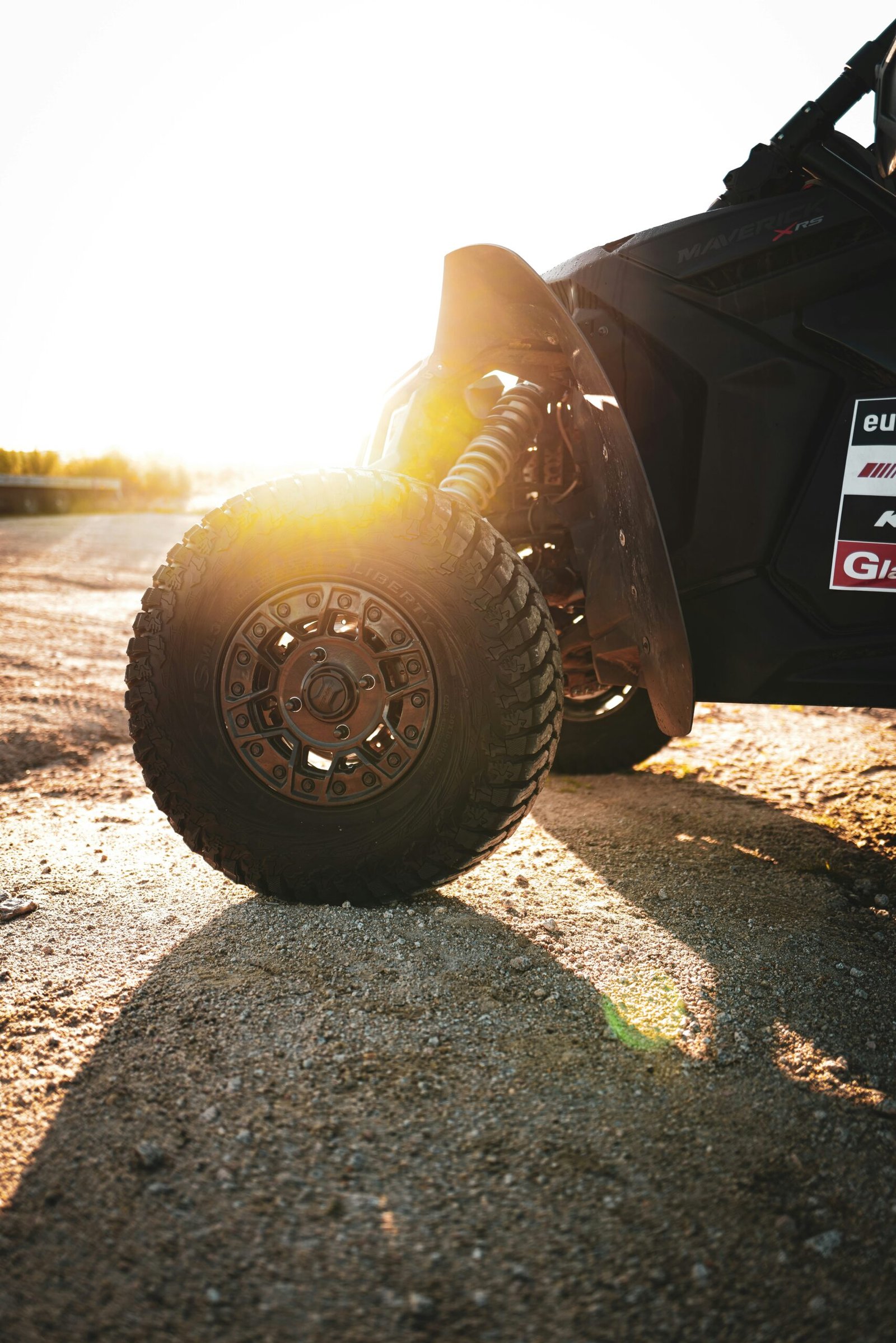Have you ever wondered why some ATV tires seem to last longer than others? Perhaps you’re curious about what factors play a role in determining the durability of ATV tires. In this article, we will break down the various factors that can affect the lifespan of ATV tires and provide you with information to help you make informed decisions when it comes to choosing the right tires for your off-road adventures.

This image is property of images.unsplash.com.
Types of Terrain
When it comes to ATV tire durability, the type of terrain you ride on can have a significant impact. Rough and abrasive terrains such as rocky trails or sandy dunes can wear down tires more quickly compared to smoother surfaces like mud or grassy fields.
Different types of tires are designed to excel in specific terrains, so it’s essential to choose a tire that matches the kind of terrain you typically ride on. For example, if you mostly ride on rocky terrains, opt for tires with reinforced sidewalls and durable treads to withstand the rugged conditions.
Sidewall Construction
The sidewall of an ATV tire plays a crucial role in its durability and overall performance. A sturdy sidewall can protect the tire from punctures, cuts, and abrasions that can occur when navigating rough terrains.
Tires with thicker sidewalls made of high-quality materials such as nylon or Kevlar are more resistant to damage and can provide better stability and control. Additionally, sidewall reinforcements can help distribute the weight of the ATV more evenly, reducing the risk of sidewall failures and extending the lifespan of the tire.
Tire Pressure
Maintaining the correct tire pressure is essential for maximizing the durability of ATV tires. Improper tire pressure can lead to premature wear, reduced traction, and poor handling, ultimately shortening the lifespan of the tires.
Overinflated tires are more prone to impact damage and can result in a harsh and uncomfortable ride. On the other hand, underinflated tires are susceptible to excessive flexing, leading to increased heat buildup and accelerated wear.
To ensure optimal tire performance and longevity, regularly check and adjust the tire pressure according to the manufacturer’s recommendations based on the ATV’s weight and the type of terrain you ride on. Investing in a quality tire pressure gauge can help you easily monitor and maintain the right pressure levels for your ATV tires.
Importance of Proper Alignment
In addition to tire pressure, proper alignment is another crucial factor that can impact the durability of ATV tires. Misaligned tires can cause uneven wear patterns, vibrations, and handling issues, leading to premature tire damage and replacement.
Regularly inspecting and adjusting the alignment of your ATV tires can help ensure that they wear evenly and last longer. If you notice any signs of misalignment such as uneven tread wear or steering pull, it’s essential to have a professional mechanic properly align your tires to prevent further damage and extend their lifespan.

This image is property of images.unsplash.com.
Tread Design
The tread pattern of an ATV tire plays a vital role in determining its durability and performance on different terrains. The depth, spacing, and arrangement of the treads can affect traction, handling, and resistance to wear.
ATV tires with aggressive tread designs featuring deep lugs and self-cleaning grooves are ideal for muddy, rocky, and challenging terrains. These treads can provide better traction, grip, and stability, allowing you to navigate through various obstacles with ease.
On the other hand, tires with shallower treads and closely spaced lugs are suitable for smoother terrains like hard-packed dirt or grass. While these treads may not offer the same level of traction as aggressive treads, they can provide better handling and durability for less demanding riding conditions.
Tread Compound
The type of rubber compound used in ATV tire treads can also impact durability and performance. Soft compounds offer better traction and grip but tend to wear out more quickly, especially on abrasive terrains. Harder compounds, on the other hand, are more durable and long-lasting but may sacrifice some traction.
Some ATV tires feature dual or multi-compound treads that combine the benefits of both soft and hard rubber compounds. These tires are designed to offer a balance of traction, durability, and longevity, making them suitable for a wide range of riding conditions.
When choosing ATV tires, consider the type of terrain you ride on most frequently and select a tread compound that aligns with your riding style and preferences.
Load Capacity
The load capacity of ATV tires refers to the maximum weight that the tires can safely carry under normal operating conditions. Exceeding the recommended load capacity can put undue stress on the tires, leading to accelerated wear, overheating, and potential blowouts.
Before purchasing ATV tires, it’s crucial to determine the maximum weight that your ATV can handle and select tires with a load rating that matches or exceeds the vehicle’s weight capacity. Overloading your ATV can not only compromise tire durability but also impact safety and handling, so it’s essential to follow the manufacturer’s guidelines.
Importance of Proper Inflation
Properly inflating your ATV tires according to the manufacturer’s recommendations is key to maintaining their load capacity and durability. Underinflated tires can become overloaded more easily, leading to excessive flexing, heat buildup, and premature wear.
On the other hand, overinflated tires may not be able to properly support the weight of the ATV, increasing the risk of impact damage and reduced traction. Regularly checking and adjusting tire pressure based on the load capacity and type of terrain can help prolong the lifespan of your ATV tires and ensure safe and optimal performance.

This image is property of images.unsplash.com.
Storage and Maintenance
Proper storage and maintenance practices are essential for preserving the durability and longevity of ATV tires. Improper storage conditions or neglecting routine maintenance can result in premature wear, dry rot, and other issues that can compromise tire performance.
Storage Tips
When storing ATV tires, it’s essential to keep them in a cool, dry, and well-ventilated area away from direct sunlight, heat sources, and harsh chemicals. Storing tires outdoors or in extreme temperatures can accelerate dry rotting and deterioration, reducing their lifespan.
To prevent flat spotting or distortion, it’s recommended to stack tires horizontally or hang them vertically on a tire rack. Keeping tires off the ground and away from moisture, oil, and other contaminants can help maintain their structural integrity and performance over time.
Maintenance Practices
Regularly inspecting and maintaining ATV tires can help identify potential issues early on and prevent premature wear and damage. Inspect tires for cuts, punctures, bulges, or other signs of damage, and replace or repair any damaged tires promptly to avoid safety hazards.
Maintaining proper tire pressure, alignment, and tread depth is crucial for maximizing tire durability and performance. Additionally, rotating tires regularly can help ensure even wear patterns and extend the lifespan of the tires.
Manufacturer Recommendations
Following the manufacturer’s guidelines and recommendations is crucial for maintaining the durability and performance of ATV tires. Manufacturers provide specific instructions regarding tire pressure, load capacity, tread depth, and other factors that can influence tire longevity.
Warranty Information
Many ATV tire manufacturers offer warranties or guarantees that cover defects in materials or workmanship for a certain period. Understanding the terms and conditions of the warranty can help you take advantage of any coverage in case of unexpected issues or premature tire wear.
Be sure to follow the manufacturer’s recommended maintenance schedule and use tires within their intended purposes to ensure warranty eligibility. Keep records of purchases, maintenance, and repairs to provide proof of ownership and protect your investment in high-quality ATV tires.
Conclusion
In conclusion, the durability and lifespan of ATV tires are influenced by various factors such as terrain, tire pressure, tread design, load capacity, and maintenance practices. By understanding these factors and following proper guidelines, you can ensure that your ATV tires perform optimally and last longer on your off-road adventures.
Choosing the right ATV tires that match your riding style, terrain preferences, and load capacity can make a significant difference in tire durability and overall performance. Regularly inspecting and maintaining your tires, following manufacturer recommendations, and storing them properly can help you maximize their longevity and enjoy safe and enjoyable rides for years to come.
Remember, investing in high-quality ATV tires and taking care of them can pay off in the long run by reducing the frequency of tire replacements, enhancing your riding experience, and ensuring your safety on the trails. Enjoy your off-road adventures with confidence and peace of mind knowing that you have the right tires that can handle the challenges ahead.




